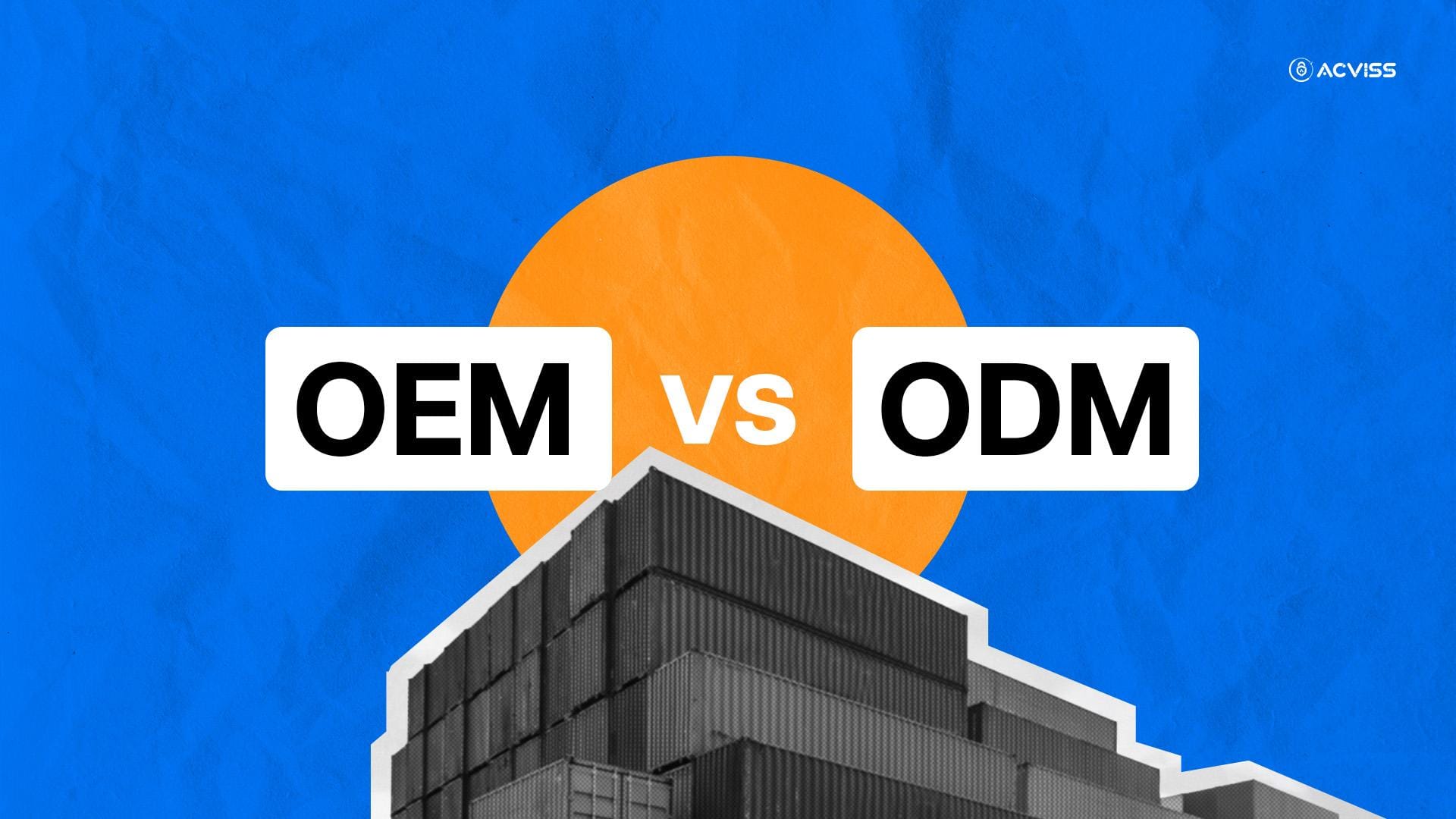OEM vs ODM: What Does It Matter for Your Supply Chain

In global manufacturing, two acronyms frequently surface in strategic discussions: OEM (Original Equipment Manufacturer) and ODM (Original Design Manufacturer). While the terms may appear deceptively similar at first glance, both imply third-party involvement in production; their implications for your supply chain, cost structure, intellectual property (IP) security, and time-to-market are dramatically different. Choosing between OEM and ODM is not merely a procurement decision; it is a strategic pivot that can shape a company’s trajectory regarding innovation, branding, compliance, and customer experience.
So, what exactly sets them apart, and why does that distinction matter more than ever in today’s fragmented, fast-paced global supply chain environment?
Understanding OEM: The Execution Arm of Your Vision
An Original Equipment Manufacturer produces products based on the specifications, blueprints, and intellectual property of the brand owner. The fundamental ownership of the product concept, design, and IP remains with the hiring company. The OEM, in essence, acts as an execution partner, often highly specialised, deeply integrated with the brand’s R&D processes, and capable of scaling manufacturing with precision and consistency.
For instance, a tech company designing a unique wearable device might collaborate with an OEM to manufacture the hardware components, relying on the OEM’s capabilities in precision tooling, assembly, and quality assurance. The design, brand identity, user interface, and all the associated software and firmware are owned and controlled by the brand.
The key advantage of this model lies in control. With OEM, businesses retain full oversight over product design and development, which translates into stronger brand identity, better IP protection, and more robust differentiation in the market. However, this also means a greater burden of responsibility. The company must invest in R&D, navigate regulatory approvals, conduct quality checks, and maintain a rigorous supply chain to avoid disruptions.
Understanding ODM: The Turnkey Route to Market

On the flip side, an Original Design Manufacturer not only produces the product but also designs it. Here, the intellectual property often originates from the manufacturer, who owns the product blueprint. Brands can either opt for a ready-made solution, typically white-labelled and slightly customised, or work with the ODM to modify the design and specifications to align better with market needs.
This model is especially attractive to companies looking to reduce time-to-market, lower product development costs, or test new categories without overcommitting internal resources. Start-ups and new entrants often gravitate toward ODMs because they offer end-to-end solutions, including prototyping, tooling, testing, compliance documentation, and sometimes even packaging and logistics.
However, the ease of entry comes at a cost. Brands relying on ODMs often face limitations in product differentiation. The same ODM design could be sold to multiple brands with minor aesthetic tweaks, diluting uniqueness and making price competition fierce. Moreover, IP ownership can be murky, especially when modifications are made to an existing ODM design, raising the risk of legal disputes or market confusion down the line.
Strategic Implications for Supply Chain Management
The OEM vs. ODM decision does not exist in a vacuum. It impacts every node in your supply chain, from sourcing and production to compliance, inventory management, and after-sales service. Let’s break down the key differences and the ripple effects they cause.
1. Product Development and Innovation Control
OEM partnerships are ideal when a company wants to retain ownership over innovation. Here, you lead the design and control the IP. This allows for tailored features, distinctive user experiences, and full branding freedom. It also empowers you to evolve the product independently of the manufacturer’s roadmap.
ODM arrangements, by contrast, limit the levers of innovation available to you. While you may be able to make adjustments, such as changing the material or firmware, reconfiguring features, or rebranding, it still operates within the boundaries set by the ODM’s technical infrastructure and design principles.
From a supply chain perspective, this directly influences lead times, component sourcing complexity, and flexibility in responding to market feedback. OEMs can be slower to start but offer long-term agility. ODMs offer speed but can create dependencies that are hard to break if you want to pivot or evolve.
2. Cost Structure and Capital Allocation
At a glance, ODMs might appear more cost-effective. You bypass the heavy upfront investment in design, tooling, testing, and certification. The ODM shoulders the burden of development, which they amortise across multiple clients. For new market entrants or companies with limited technical expertise, this model provides a clear financial advantage.
However, with OEMs, although initial costs are higher due to R&D investments, the unit economics often improve over time. Once volumes scale, the cost per unit tends to decrease, and the ownership of design means there are no licensing fees or restrictions. Moreover, you retain the option to switch manufacturers or bring production in-house without redesigning the product from scratch.
This cost-benefit analysis must also factor in hidden risks, such as quality control lapses, supply chain disruptions, or long-term inflexibility with ODMs. In contrast, OEMs enable deeper integration into your operations, allowing you to build resilience through redundancy, multi-sourcing strategies, and better forecasting.
3. Intellectual Property and Competitive Edge

Perhaps the most critical consideration in today’s IP-sensitive climate is ownership of design and technology. OEMs build your design; they do not own it. That creates a clear demarcation that helps protect trade secrets, patented features, and brand-specific innovations.
With ODMs, IP boundaries are blurrier. While you may own your brand, packaging, and user experience, the underlying design often belongs to the ODM. This can lead to legal grey areas if multiple brands use similar base products or if you later wish to modify or move the product to a different manufacturer.
From a supply chain integrity standpoint, this also affects trust and transparency. When working with OEMs, you can embed traceability solutions, blockchain authentication, or smart labelling systems into the manufacturing process, enabling greater control over counterfeiting, diversion, or warranty fraud.
4. Quality Assurance and Compliance
When working with OEMs, quality is a shared commitment but driven by your standards. You determine the specifications, test protocols, and compliance requirements. This alignment ensures that regulatory approvals, be it CE, RoHS, FDA, ISO, or others, are embedded early in the product lifecycle.
ODMs, on the other hand, maintain quality standards based on their internal benchmarks. While this may be sufficient for standard products, it might fall short for industries like pharmaceuticals, automotive, or medtech, where compliance requires custom documentation, traceability, and rigorous batch testing.
Moreover, the ability to conduct root-cause analysis during product failures is much more granular with OEMs. Since the entire product is built on your blueprint, you can investigate issues with greater technical clarity, helping reduce warranty claims, product recalls, and customer dissatisfaction.
5. Supply Chain Flexibility and Risk Management

Supply chain agility is becoming a strategic differentiator, especially in the face of global disruptions, geopolitical shifts, and evolving customer demands. OEM partnerships, while slower to establish, tend to offer more flexibility in scaling operations, shifting geographies, or adapting components based on availability and cost.
ODMs, by contrast, are bound by their internal supply chain networks. Component substitution, alternate sourcing, or process changes are often difficult or impossible without renegotiating the contract or selecting a different product variant. For fast-moving markets, this rigidity can be a significant risk.
OEM relationships allow for tighter integration with upstream suppliers, giving you better forecasting visibility, stronger ESG compliance, and more proactive risk mitigation mechanisms. ODMs, being a black box in many cases, restrict your visibility beyond the final product, which can be problematic for industries facing tightening regulations on sourcing, sustainability, or labour practices.
Comparative Table: OEM vs. ODM vs. Aftermarket Parts
Factor | OEM (Original Equipment Manufacturer) | ODM (Original Design Manufacturer) | Aftermarket Parts |
|---|---|---|---|
Design Ownership | The brand/company owns the product design and specifications. Full control over innovation and product roadmap. | The manufacturer owns the design. Buyers may customise or white-label, but base design is typically reused across multiple clients. | Independent third parties design components to fit existing products. No affiliation with the original brand. |
Manufacturing Responsibility | OEM manufactures as per the brand’s exact design and specification. | ODM both designs and manufactures the product. | Manufactured independently, often with no access to original specifications or tolerances. |
Branding | The product is branded under the company’s label with complete customisation. | Branded under the buyer’s label, but with potential design reuse across other brands. | Generally not sold under the original brand. Often, generic or under the supplier’s brand. |
Intellectual Property (IP) | IP is owned and protected by the brand. OEM acts under contract without claim to the design. | IP is typically owned by the ODM. Buyers may face limitations on IP rights and usage. | No IP linkage to the original product; may pose risks if design infringes on patents or trademarks. |
Quality Control | High-quality standards are set and audited by the brand. Allows granular control over processes. | Medium to high, but dependent on the ODM’s internal benchmarks and focus. Customisation can reduce predictability. | Variable. May not meet OEM standards. Quality depends heavily on the supplier’s capabilities and intent. |
Product Differentiation | High. Fully unique design aligned with brand identity and customer expectations. | Moderate. Some scope for differentiation, but constrained by shared base design. | Low. Designed to mimic or fit OEM products, but lacks uniqueness or proprietary features. |
Speed to Market | Slower due to in-house R&D, prototyping, testing, and compliance timelines. | Faster, as the design is pre-developed. Ideal for rapid category testing or entry. | Fastest. Readily available products with no development time, often purchased off the shelf. |
Cost (Initial Investment) | High. Significant R&D, tooling, and testing investments are required. | Moderate. Design costs are absorbed by ODM and amortised over multiple clients. | Low. No development costs are involved; however, long-term risks may lead to higher lifecycle costs. |
Unit Cost (Long Term) | Lower at scale due to direct control, economies of scale, and design ownership. | May remain moderate or increase with customisation. Limited leverage on pricing. | Usually lowest upfront, but may involve hidden costs from lower durability, recalls, or legal issues. |
Regulatory Compliance | Fully aligned with brand-specific regulatory and market standards. Easier to certify and document. | Compliance is managed by the O DM. Buyers may have less visibility and influence on documentation and traceability. | Risk-prone. May not comply with required safety or environmental regulations, especially in critical industries. |
Supply Chain Flexibility | High. Ability to switch suppliers, multi-source components, or modify designs with agility. | Limited. Bound to the ODM’s supply chain and design framework. Difficult to shift without starting over. | High availability but lacks integration with supply chain visibility tools or quality assurance processes. |
After-Sales Service/Support | Strong. OEM parts and products are easier to service, update, or integrate with warranties. | Moderate. Support may be restricted to the ODM’s ecosystem. Updates or servicing may be delayed. | Weak or inconsistent. Typically not covered under warranty. May void original product warranties if used as replacements. |
Best Fit For | Companies with strong R&D capabilities looking to innovate, differentiate, and scale with full control. | Businesses prioritising speed, cost-efficiency, and minimal technical investment—especially for generic or fast-moving consumer goods. | Cost-sensitive buyers, replacement parts market, or businesses in need of temporary or experimental solutions where longevity and compliance are secondary. |
So, Which Model is Right for You?
The answer depends on your business model, core competencies, and long-term goals.
If you are a design-driven brand focused on innovation, differentiation, and intellectual property, the OEM path allows you to retain control and carve a defensible niche in the market. It suits companies that want to own their destiny, whether through exclusive feature sets, tight compliance frameworks, or unique customer experiences.
If speed, cost-efficiency, and market testing are your priorities, especially for commodities, consumer electronics, or private label expansions, then ODM offers a plug-and-play route. It allows you to experiment, diversify, and pivot quickly with minimal financial exposure.
Ultimately, many successful companies adopt a hybrid strategy. They use ODMs for peripheral products or early-stage launches, and transition to OEMs as the product matures, gains traction, or requires deeper market integration. Some begin with an ODM to validate their idea, then redesign the product under an OEM model to scale responsibly and protect IP.
Strategic Choice, Long-Term Impact
Choosing between an OEM, ODM, or aftermarket model isn’t simply a matter of cost or convenience—it’s a foundational decision that defines your product integrity, brand trust, and supply chain resilience. OEMs provide unparalleled control and quality, ODMs offer speed and scalability, and aftermarket parts can serve cost-sensitive needs, but often at the expense of authenticity and traceability.
That’s where Acviss comes in.
Our advanced suite of anti-counterfeiting and traceability technologies—powered by non-cloneable labels, AI surveillance, and blockchain infrastructure—empowers brands to take control of their supply chain, regardless of the manufacturing model they adopt. Whether you're designing proprietary OEM products or white-labelling through ODMs, Acviss ensures your goods remain authentic, secure, and verifiable—from the factory floor to consumer hands.
Reach out to us for a tailored solution that protects your products and your reputation.
